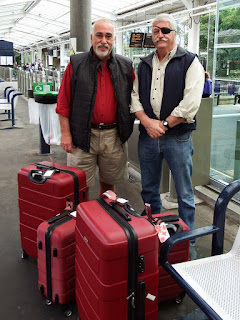Karl Marx & Douglas Adams
Being, as I am, a free-market socialist along the lines of the Nordic Model, it was important to me to make a pilgrimage to the grave of Karl Marx at Highgate Hill Cemetery in London's North. After all, pilgrimages are so very in these days and where better to be trendy than London?
 |
| Karl Marx's Grave |
Seriously though, this man helped shape the Labour Movement across the world and for that I honour him. He was worth a visit! Damned shame I didn't take the right map when we set off!
I determined that Arch Tube Station was the nearest so off we went. It was a late start and, immediately turning the wrong way out of the station, we discovered a rather nice Turkish restaurant. There went an hour but we had a lovely lunch and I discovered that I understand Turkish people much better than I do a good many Northerners - but then we did live in the Municipality of Auburn for 15 years.
After another hour of blind wandering I finally hailed a cab and we were there in no time at all with two more things crossed off the list: Karl Marx's grave and a London cab ride.
Highgate Hill Cemetery is a dense urban forest punctuated by cheek and jowl memorials. I have no idea how they actually manage to bury anyone there but suspect that most internments these days are actually ashes. This must certainly be the case with Douglas Adams, the first notable internee of interest we came upon.
If I were to be told I could only ever read one more book for the rest of my life it would be 'The Hitchhiker's Guide to the Galaxy' - all five of them, of course. I love this man's mind, his utter absurdity yet illogical logic. Clearly, many others do as well. There is a collection of pens in front of his headstone, a collection we witnessed grow by four while we were there. I had my photograph taken hitchhiking with him, as I hope he would have me do.
 |
| Hitchhiking with Douglas Adams |
Karl Marx's grave is truly monumental in every sense. He shares it with his wife and several other family members, all relocated from another part of the cemetery in 1954 - a very auspicious year. I'm not sure I'm particularly fussed on graves, I feel no particular need to visit the place where my parents' ashes are interned, but I felt just a little driven to stand before that extraordinarily powerful bust of Karl Marx.
Rollin' on the River
We chose the most glorious day to ride up the river from Westminster to the Thames Barrier and back and what an amazing stricture the latter is. It protects London against unusually high tides and and flood surges has done so over 50 times since it opened in 1982 with its massive walls rising from the riverbed is just a matter of minutes.
Once on the Thames you start to get an idea just how big London is, not so much in terms of sprawl but of density. It doesn't have a central business district like Sydney, it has dozens of them scattered around a radius of about 10km out from the centre with more developing as I write. The main area of growth is the Docklands where shipping has given way to business, commercial and residential developments and hundreds upon hundreds of cranes reaching skyward simply everywhere. London already has a population density of 5,500 people per square kilometre compared to Sydney's 380 which gives me an insight into exactly why the Underground and many parts of the city are a glimpse into hell. I felt a sense of much needed space out on the river.
We're Bound for Botany Bay
A very productive chat with the boat crew set us off in search of the site of our ancestral convict prison hulks when we returned to Westminster. In fact they weren't far from Parliament itself, just a little upstream at Millbank. They were moored outside Millbank Prison which once stood there, now the site of the Tate Gallery.
The rotten hulks were a five year solution to prison overcrowding, a solution which lasted a full eighty years until transportation finally ended. A large stone bollard marks the spot where the convicts were loaded for their one-way journey to Australia. My desire to find the actual site overshadowed any thoughts I had about it until I stood there, on the spot, thinking about how my ancestors must have felt as they left their homeland forever and not by choice. This is an extremely powerful place.















